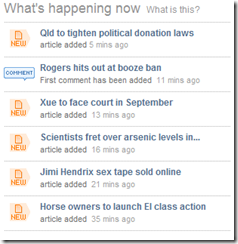I just finished watching Stowe's talk at Reboot about something he calls 'Flow'.
You can watch it
on CoRrElate.
Eric Norlin on the Defrag blog
summarized the talk pretty well:
Stowe's basic argument (simplistically paraphrased) is that the tools we're using (social networking, etc) are actually changing the way our neurons are dealing with things - and that has led to 2 central propositions:
1. Time is a shared resource.
2. Connectivity is more important that productivity
As I have written before about Stowe's thoughts on Flow, I think that, for the most part, Stowe is on to something very interesting.
In fact I have been touching on the subject for a while now by arguing that news and alerts should not be treated like email with folders and items to be marked as read. They should flow by you in a news ticker, river of news and/or popup alerts.
As I wrote in my last post on the subject, the only concern I have with Stowe's thesis is that he seems to quickly dismiss the concept of the 'Attention Economy' without quite understanding the implications.
He claims that Information Overload and the economic metaphor for Attention does not fit. He means that we can not assign units of measurement to our Attention and allocate it as a finite resource because Attention can actually be tuned and improved with a physical changing and training of our neurons to perceive the world as a flow - letting the information flow over us. Just like a juggler learns to juggle many balls as a matter of instinct.
That may be true - and he is right that part of the Attention Economy is about assigning value to attention and trying to allocate it most effectively.
However, he is missing the fact that there are 2 aspects to the emerging Attention space that invoke economic theory:
- Attention is a finite resource and can be dealt with in terms of economic units that can be consumed - therefore an abundance of Information creates a scarcity of Attention.
- Attention data can be used to better target goods and services. The trading of this attention data, and the resulting efficient selection and presentation of advertising to drive sales is becoming an important economic driver.
Stowe seems to disagree only with the first point (I could be wrong - care to clarify Stowe?).
Firstly, I don't think it is as black and white as he states when it comes to point 1 - efficient allocation of our Attention.
Sure we can change our neurons and practice living a life of flow - in fact I advocate that we do - that's why Particls' primary interface right now is a news ticker and not a set of folders and items.
However, I think that tools that use Attention to better focus our stream can only help the process. A tool to funnel and tune the incoming information and present it in a method that is conducive to flow thinking can only be helpful.
On point 2. People are making money off your Attention. They are observing it, recording it and fine tuning advertising and content around it. They are also selling the data to each other. This gives it economic value. The question then is who owns this value and what are our rights as generators of the information and recipients of targeted information.
There is a real economy developing around this practice and standards like APML are about giving us participants some control back.
